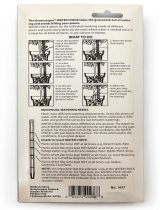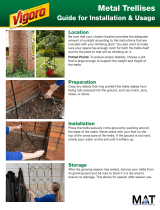Sweet Berry Selections RSBPOKAQT User manual
- Type
- User manual

Everbearing Raspberry Planting Instructions
Selecting a Planting Site
To get the most out of your raspberry planting, choose your site carefully. Raspberries prefer full sunlight and
grow best in well-drained, sandy loam soils rich in organic matter. Avoid low areas that remain wet late into the
spring, but select a site with access to a water supply. Irrigation is important for good plant growth during dry
periods and can improve fruit size and yield. Destroy all wild raspberry and blackberry plants within a distance of
600 feet of your planting site if possible, to reduce the possibility that virus diseases might be spread to your
planting.
The Raspberry Plant
The crowns and roots of raspberry plants are perennial, but individual canes live two years. Each spring, the
plants produce canes (suckers) from buds on the crown and on underground lateral stems. Everbearing
raspberries bear a crop on the tips of first-year canes in the fall, followed by a typical summer crop on the lower
portion of the canes the second year.
It’s easy to tell first-year canes from second-year canes. First-year canes have green stems, while second-year
canes have a thin, brown bark covering them.
Planting and Management Systems
Plant raspberries early in the spring after the danger of severe frost is past (late April to mid-May) or late fall
while the soil is still warm. Do not allow plant roots to dry out before or during planting. Plants should be set at
the same depth or slightly deeper than they were in the pot. Firm the soil around the roots and water the plants.
Red raspberry plants are typically grown in a hedgerow. Crowns should be planted about 2 feet apart in rows
that are 8 to 12 feet apart. The plants will soon send up suckers from the roots and crowns to form a hedge,
which should be maintained at 12 to 18 inches wide at the base. Individual plants can be grown as a large
shrub following the same annual cane pruning used for hedgerow planting.
Raspberries are best grown with some sort of a trellis. This will improve fruit quality, make harvesting easier,
and reduce disease problems. Trellises also make pruning simpler by encouraging new cane growth in the
middle of the row, rather than just along the outside edges. For plants grown in a hedgerow, the “T” or “V” trellis
systems are recommended.
For the T trellis, sturdy posts should be set in the
row with 3½-foot-long cross arms affixed at a
height of 3½ to 4½ feet. The posts should be set
at least two feet deep in the ground and
anchored at each end of the row. Secure heavy-
gauge wire along the length of the row on each
side of the cross arms (Figure 1).
Figure 1. "T" Trellis

For the V trellis, two posts should be set at each
end of the row at about a 30-degree angle so that
they are 3½ feet apart at a height of 3½ feet. Run
the wire from each post at 3½ feet (Figure 2).
After pruning, tie the fruiting canes to the wires
on each side.
Figure 2. "V" Trellis
Care and Fertilization
Keep the planting free from weeds with shallow cultivation and hand pulling as necessary. Make sure the plants
receive one to two inches of water a week for best growth. Mulch can be used to reduce weed problems within
the plant rows and also to help retain soil moisture and add valuable organic matter. Spread wood chips, bark,
pine needles, or rotted leaf mulch over the plant rows, and maintain it at a depth of three to four inches.
Raspberries should be fertilized each year in the early spring (mid-April). Apply 2 pounds of 10-10-10 (or organic
equivalents) per 100 square feet of the planting It is best to split the application, applying half of the
recommended amount in mid-April and the second half four to six weeks later.
Pruning
Pruning is a vital part of maintaining a healthy raspberry planting. This practice greatly inhibits the spread of
raspberry diseases and improves fruit quality and yield. During the summer months, regularly remove all new
canes that emerge outside the desired plant row width of 12 to 18 inches. This improves light penetration and air
circulation for the canes in the middle row that will fruit next year. Also remove any canes that show obvious
signs of insect or disease injury. Maintaining this narrow row width will assure adequate light penetration and air
circulation to promote healthy cane growth and reduce disease problems. Only the most vigorous canes, those
with the greatest height and basal diameter, should be left in the row. Continue thinning until only four to five
canes per foot of row length remain. These remaining canes should be attached to the trellis wires with twine.
Finally, remove all of the plant waste from the field. Plant waste can harbor diseases and insects that may attack
the healthy canes.
Everbearing or fall-bearing red raspberries bear a fall crop on first-year canes and a summer crop on the lower
part of the canes the following year. Remove the two year canes after summer fruiting and encourage new
shoots for a fall crop.
Harvesting
Raspberries are ready to pick when they easily separate from the receptacle or core. To maintain fresh quality,
place fruit in shallow containers, no more than three berries deep, and cool the fruit in the refrigerator as quickly
as possible. Fruit properly harvested and held at this temperature can maintain fresh quality for three to seven
days. If the fruit is to be made into jam or jelly, process it immediately, or freeze it until ready to use.
-
 1
1
-
 2
2
Sweet Berry Selections RSBPOKAQT User manual
- Type
- User manual
Ask a question and I''ll find the answer in the document
Finding information in a document is now easier with AI
Related papers
Other documents
-
Sunnydaze Decor HMI-784 User manual
-
 Master Garden Products WTT-48F Operating instructions
Master Garden Products WTT-48F Operating instructions
-
New England Arbors VA68201 User manual
-
 GREENSCAPES 202368 Installation guide
GREENSCAPES 202368 Installation guide
-
Gurney's 08517 User manual
-
MGP TPF-48 Installation guide
-
Vigoro 06053 User manual
-
 Vigoro 861185VG Installation guide
Vigoro 861185VG Installation guide
-
Unbranded 74202 User manual
-
Costa Farms 10MASSCREAMMOD User manual








